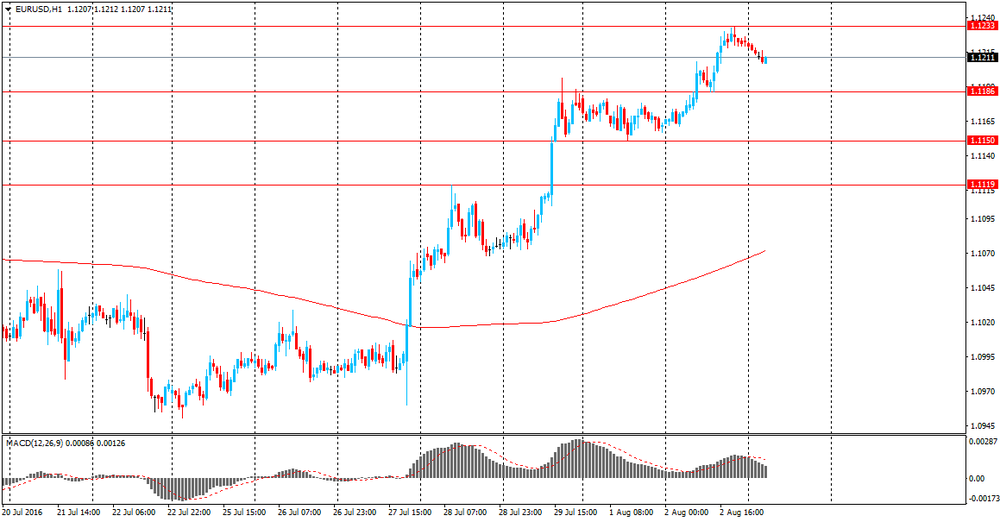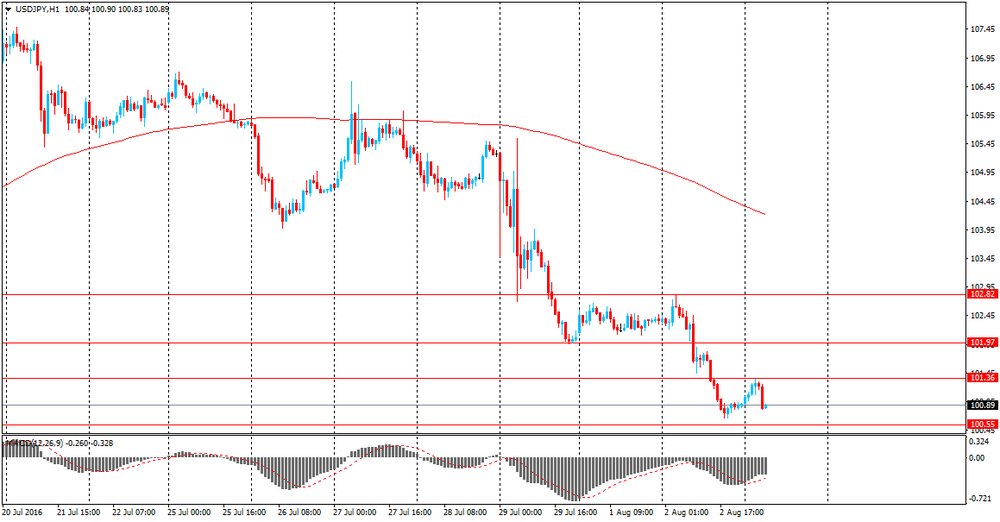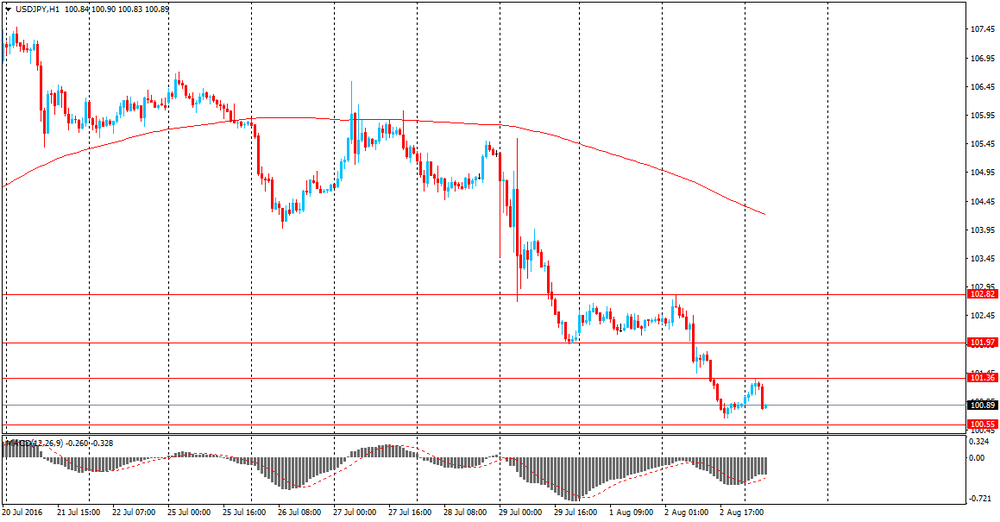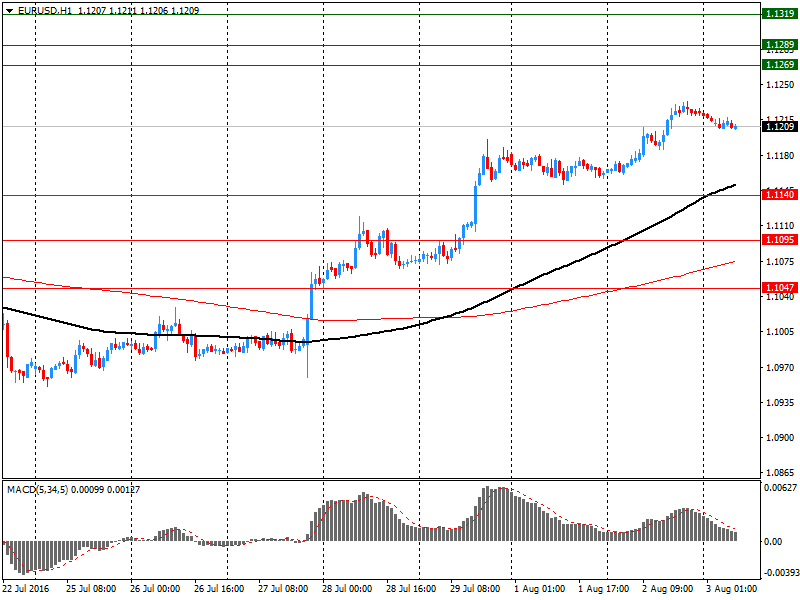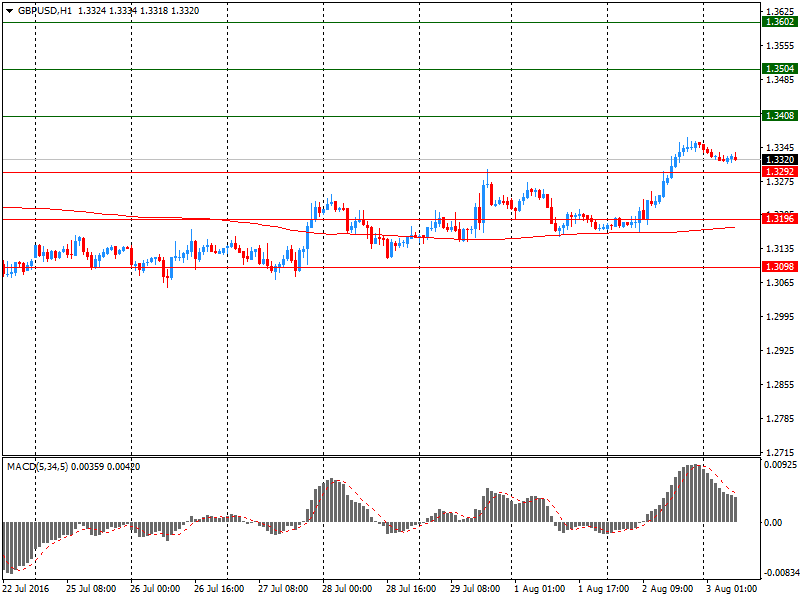Noticias del mercado
-
16:30
U.S.: Crude Oil Inventories, July 1.413 (forecast -2)
-
16:06
US ISM non-manufacturing down 1 point from the previous month
Anthony Nieves, CPSM, C.P.M., CFPM, chair of the Institute for Supply Management® (ISM®) Non-Manufacturing Business Survey Committee:"the NMI® registered 55.5 percent in July, 1 percentage point lower than the June reading of 56.5 percent. This represents continued growth in the non-manufacturing sector at a slower rate. The Non-Manufacturing Business Activity Index decreased to 59.3 percent, 0.2 percentage point lower than the June reading of 59.5 percent, reflecting growth for the 84th consecutive month, at a slightly slower rate in July. The New Orders Index registered 60.3 percent, 0.4 percentage point higher than the reading of 59.9 percent in June. The Employment Index decreased 1.3 percentage points in July to 51.4 percent from the June reading of 52.7 percent. The Prices Index decreased 3.6 percentage points from the June reading of 55.5 percent to 51.9 percent, indicating prices increased in July for the fourth consecutive month. According to the NMI®, 15 non-manufacturing industries reported growth in July. The majority of the respondents' comments reflect stability and continued growth for their respective companies and a positive outlook on the economy."
-
16:00
U.S.: ISM Non-Manufacturing, July 55.5 (forecast 56)
-
16:00
Growth in the US services sector remained muted
July data suggested that growth in the U.S. service sector remained muted, with activity rising at the weakest pace in the current five-month sequence of expansion. A slower increase in new business was also recorded. On a more positive note, the rate of job creation picked up slightly and business sentiment improved markedly from June's record low. On the price front, slower increases were registered for both input costs and output prices during the month.
The seasonally adjusted Markit final U.S. Services PMI™ Business Activity Index1 registered 51.4 in July (earlier 'flash' estimate: 50.9), which was unchanged from the figure recorded in June and above the neutral 50.0 threshold for the fifth consecutive month. However, the latest reading remained indicative of only a very modest expansion of business activity that was softer than the post-crisis trend (55.4).
-
15:46
U.S.: Services PMI, July 51.4 (forecast 50.9)
-
15:30
Option expiries for today's 10:00 ET NY cut
EUR/USD 1.1125 (EUR 500m) 1.1212 (270m)
USD/JPY 99.50 (USD (500m)
GBP/USD 1.3300 (GBP 370m)
EUR/GBP 0.8350 (EUR 260m)
AUD/USD 0.7500 (AUD 300m) 0.7540 (1.1bln)
USD/CAD 1.3100 (USD 421m)
-
14:25
US: Private sector employment increased above forecasts in July
Private sector employment increased by 179,000 jobs from June to July according to the July ADP National Employment Report®
Payrolls for businesses with 49 or fewer employees increased by 61,000 jobs in July, down from 86,000 in June. Employment at companies with 50-499 employees increased by 68,000 jobs, up from last month's 56,000. Employment at large companies - those with 500 or more employees - increased by 50,000, up from June's 34,000. Companies with 500-999 employees added 16,000 and companies with more than 1,000 employees added 33,000 in July. Goods-producing employment was down by 6,000 jobs in July, following June losses of 28,000. The construction industry lost 6,000 jobs, following June losses of 4,000 jobs. Meanwhile, manufacturing gained 4,000 jobs after losing 15,000 the previous month.
-
14:15
U.S.: ADP Employment Report, July 179 (forecast 170)
-
13:45
Orders
EUR/USD
Offers : 1.1220 1.1230-35 1.1250 1.1280 1.1300-05 1.1335-40 1.1400
Bids: 1.1200 1.1180 1.1150 1.1120 1.1100 1.1085 1.1050
GBP/USD
Offers : 1.3320 1.3335 1.3355 1.3365 1.3385 1.3400 1.3450 1.3470 1.3500
Bids: 1.3280-85 1.3265 1.3250 1.3230-35 1.3200 1.3170 1.3150 1.3130 1.3100 1.3085 1.3050
EUR/GBP
Offers : 0.8450-55 0.8485 0.8500 0.8525 0.8550
Bids: 0.8400 0.8385 0.8365 0.8350 0.8330 0.8300
EUR/JPY
Offers : 113.50 113.80 114.00 114.50 114.80 115.00 115.20 115.50 115.80 116.00
Bids: 113.00 112.80 112.60 112.00-10 111.50 111.00 110.80-85 110.50
USD/JPY
Offers : 101.30-35 101.50 101.75-80 102.00 102.30 102.50-55 102.75-80 103.00 103.30 103.50
Bids: 101.00 100.65-70 100.50 100.00 99.85 99.50 99.30 99.00
AUD/USD
Offers : 0.7600 0.7620 O.7635 0.7650-55 0.7700 0.7720 0.7750
Bids: 0.7570 0.7570 0.7540-50 0.7520 0.7500 0.7480-85 0.7450 0.7420 0.7400
-
13:45
GBP: Risk For Selling Into And After BoE - Citi
"Our economics team is forecasting a 25bp cut in the bank rate and a resumption of QE - forecasting 75bn in purchases over the next 4-months. Forecasts for inflation and growth will be reduced.
The risk to sterling is two-fold:
Given the market expectations have been building for weeks, the bar for the BOE to deliver will be fairly high leaving an upside surprise difficult.
Still, we remain bearish on GBP. A resumption to rate cuts and asset purchases would be a long-run signal for Real Money accounts that have been slow to rebalance their asset holdings.
From that angle we see room for some GBP selling into and after the event" - efxnews.
-
11:07
Euro Zone retail sales volume unchanged in June
In June 2016 compared with May 2016, the seasonally adjusted volume of retail trade remained stable in the euro area (EA19) and declined by 0.2% in the EU28, according to estimates from Eurostat, the statistical office of the European Union. In May the retail trade volume increased by 0.4% in both zones. In June 2016 compared with June 2015 the calendar adjusted retail sales index increased by 1.6% in the euro area and by 2.4% in the EU28.
The stable volume of retail trade in the euro area in June 2016, compared with May 2016, is due to rises of 0.3% for non-food products and of 0.1% for "Food, drinks and tobacco", while automotive fuel decreased by 1.3%. In the EU28, the 0.2% decrease in the volume of retail trade is due to decreases of 1.0% for automotive fuel and 0.2% for "Food, drinks and tobacco", while non-food products increased by 0.2%. Among Member States for which data are available, the highest increases in total retail trade were registered in Portugal (+3.1%), Romania (+2.0%) and Spain (+1.0%), while the largest decreases were observed in Ireland (-1.6%), Estonia (-1.5%) and Poland (-1.0%).
-
11:00
Eurozone: Retail Sales (MoM), June 0% (forecast 0%)
-
11:00
Eurozone: Retail Sales (YoY), June 1.6% (forecast 1.7%)
-
10:39
Option expiries for today's 10:00 ET NY cut
EUR/USD 1.1125 (EUR 500m) 1.1212 (270m)
USD/JPY 99.50 (USD (500m)
GBP/USD 1.3300 (GBP 370m)
EUR/GBP 0.8350 (EUR 260m)
AUD/USD 0.7500 (AUD 300m) 0.7540 (1.1bln)
USD/CAD 1.3100 (USD 421m)
-
10:32
The UK service sector registered a fall in business activity in July
The UK service sector registered a fall in business activity in July, according to the latest PMI® survey data from IHS Markit and CIPS. Output and new business both declined for the first time in over three-and-a-half years, and at the fastest rates since early-2009. Consequently, employment in the sector was unchanged since June, ending a three-and-a-half-year period of uninterrupted job creation. The 12-month outlook for activity weakened sharply to the lowest since February 2009, linked to uncertainty regarding 'Brexit'.
The headline figure for the survey is the seasonally adjusted Markit/CIPS UK Services Business Activity Index, a single-figure measure designed to track changes in total UK services activity compared with one month previously.
Readings above 50.0 signal growth of activity compared with the previous month, and below 50.0 contraction. The Business Activity Index fell to 47.4 in July, from 52.3 in June, signalling a fall in UK services output. This was the first contraction since December 2012, and the rate of decline was the strongest since March 2009.
-
10:30
United Kingdom: Purchasing Manager Index Services, July 47.4 (forecast 47.4)
-
10:23
Stronger services activity in the Euro Zone in July
The rate of eurozone economic expansion ticked higher at the start of the third quarter. This was signalled by the final Markit Eurozone PMI® Composite Output Index rising to a six-month high of 53.2 in July, above the earlier flash estimate of 52.9. The headline index has now signalled growth for 37 successive months.
The rate of expansion in manufacturing production steadied at June's six-month high. Growth of service sector output improved slightly but remained slower than that seen at manufacturers. Although the latest data signalled a solid and steady pace of expansion, national data suggested that the upturn was uneven by nation. Growth was primarily driven by an accelerated rate of output expansion in Germany, the fastest during the year-to-date. Rates of growth moderated in Italy and Spain, whereas France continued to hover around the stagnation mark.
-
10:00
Eurozone: Services PMI, July 52.9 (forecast 52.7)
-
09:57
German service providers reported further growth
German service providers reported further growth of both output and new orders at the start of the third quarter. The respective rates of growth accelerated slightly since June and were above their respective long-run averages. Moreover, companies were encouraged to add to their payrolls, which in turn helped alleviate some pressure on operating capacity.
Meanwhile, the pass through of sharply rising input costs resulted in a further increase in overall charges. The final seasonally adjusted Markit Germany Services Business Activity Index posted above the neutral 50.0 threshold that separates growth from contraction for the thirty-eighth consecutive month in July. Rising from June's 53.7 to 54.4, the index signalled an acceleration in the rate of expansion. According to anecdotal evidence, growth in output was driven by rising demand and higher investments.
-
09:55
French services sector activity improves
Service providers in France reported a rise in business activity for the third time in the past four months during July. That said, the rate of growth was marginal overall. New business received by service providers increased moderately, contributing to a further rise in backlogs of work. Employment grew marginally, while companies' business expectations remained positive. Input prices rose modestly, whereas there was a further drop in prices charged.
The seasonally adjusted headline Markit France Business Activity Index - which is based on a single question asking respondents to report on the actual change in business activity at their companies compared with one month ago - posted 50.5 in July. Up from 49.9 in June, the latest index reading pointed to a marginal rate of expansion that was broadly in line with the average seen during 2016 so far (50.3).
The final seasonally adjusted Markit France Composite Output Index - which covers the combined manufacturing and service sectors - registered 50.1 in July. Up from 49.6 in June, the latest index reading was indicative of broadly no change in private sector activity during the latest survey period.
-
09:55
Germany: Services PMI, July 54.4 (forecast 54.6)
-
09:51
France: Services PMI, July 50.5 (forecast 50.3)
-
09:50
July’s survey highlighted stronger demand for services in Italy - Markit
Italy's services economy remained in expansion territory at the start of the third quarter, according to the latest PMI® survey data from IHS Markit. Furthermore, the pace of job creation signalled was the fastest since August 2007 amid stronger growth in incoming new business. However, firms' optimism towards the year-ahead outlook for business activity eased to the lowest for 32 months.
The headline Markit Business Activity Index - which is based on a single question asking respondents to report on the actual change in business activity at their companies compared to one month ago - moved to 52.0 in July, up fractionally from June's 51.9. That pointed to the continuation of a modest pace of growth in business activity that was broadly in line with the average over 2016 so far. The best performing sub-sector was Renting & Business Activities, followed by Financial Intermediation. Reflective of the ongoing upturn in the services economy, businesses raised employment levels for the tenth month in succession during July. Furthermore, having accelerated since June, the rate of job creation reached the fastest seen for nearly nine years. July's survey highlighted stronger demand for services in Italy, with inflows of new business having increased amid reports of new clients being acquired. The rate of growth in new work was at a five-month high, though only moderate overall.
-
09:36
Spanish service sector remained comfortably in growth territory in July
The Spanish service sector remained comfortably in growth territory in July, with further solid rises in activity and new business recorded. The rate of job creation remained marked, having eased only slightly from the previous month's recent high. Business sentiment eased, but remained positive. Meanwhile, rates of inflation of both input costs and output prices accelerated but remained muted. The headline seasonally adjusted Business Activity Index dropped slightly to 54.1 in July from 56.0 in June. The reading signalled a further solid expansion in activity, albeit the weakest since February.
Service sector output has now risen in each of the past 33 months, with panellists reporting the launch of new services and signs of improving client demand. Each of the six broad sectors monitored by the survey saw activity increase, with the sharpest expansion at Hotels & Restaurants. The category also posted a marked rise in new business, with Post & Telecommunications another strong performer.
-
09:07
Asian session review: usd stabilized
The Australian dollar was supported by strong iron ore prices and US dollar weakness. Also, the Australian currency rose by about 2% contrary to RBA decision to lower interest rates by 25 basis points to a record low of 1.50%.
Data on the index of activity in the service sector of Australia AiG show an incrase to 53.9 points, which is higher than the previous value of 51.3. Increased activity in the Australian services sector for the third consecutive month. Of the five sub-indices of the sector the highest growth was observed in the sector of sales to 59.4, the strongest level since August 2015. Deliveries rose by 6.0 points to 54.2, and inventories increased by 6.2 points to 52.8 points.
New orders remained stable at 52.2, while employment decreased by 3.1 points to 50.0 points.
Three of the nine sub-sectors were stable. Retail trade rose to 65.0, the finance and insurance to 62.0 and services to 53.2. Other sub-sectors oshowed a decline: wholesale to 48.9, personal and entertainment services to 46.7. The weakest growth rate observed in the sub-sector of transport and storage 33.6 points.
In China, Caixin services PMI fell in July to 51.7 from 52.7 the previous value. The index was also lower than the official data on business activity index of the services sector, which amounted to 53.9 points.
Caixin PMI is a leading indicator of China's state sector services. A value above 50 indicates growth, while falling below this level indicates contraction.
All index categories showed signs of deterioration. The greater deterioration observed in the employment category, which kept growing in the last three months.
The yen is trading near the yesterday's high as the Japanese government measures do not meet market expectations. The total amount of the stimulus program amounted to Y28 trillion and it became one of the most significant for Japan in the aftermath of the global financial crisis.
The US dollar traded in a narrow range against the euro, after yesterday's significant decline, helped by investors' flight from risk, as well as the widespread weakening of the US currency due to recent disappointing GDP report. Investors are concerned that the weak GDP data will reduce the likelihood of tighter monetary policy of the Fed. Today futures on interest rates suggest 18% probability of rate hike in September and 35% probability in December.
Markets gradually switched to the data on US labor market, which will be published on Friday. Some investors believe that the employment data will be strong, so that the Federal Reserve in the next few months will be able to make a rate hike.
Today, the US will release the index of business activity in the services sector from the Institute for Supply Management. The indicator is the result of a survey of about 400 companies from 60 sectors across the United States, including agriculture, mining, construction, transport sector, communications, wholesale and retail companies. The index consists of four equally weighted components: business activity, new orders, employment, suppliers and shipping. ISM index value greater than 50 is usually considered as an indicator of the growth of industrial activity, but less than 50, respectively, falls. It is expected that the index fell to 56.0 from 56.5 in June.
EUR / USD: during the Asian session, the pair was trading in the $ 1.1200-05 range
GBP / USD: during the Asian session, the pair was trading in the $ 1.3300-05 range
USD / JPY: during the Asian session, the pair was trading in Y100.75 - 101.05 range
-
08:52
Bitcoin plunged after hackers stole about $65 million - Bloomberg
Bitcoin plunged after one of the largest exchanges halted trading because hackers stole about $65 million of the digital currency.
Bitcoin slumped 5.5 percent against the dollar as of 2:30 p.m. on Wednesday in Tokyo, bringing its two-day drop to 13 percent. Prices also sank 6.2 percent on Monday, although it was not clear if that initial move was related to the hack.
Hong Kong-based exchange Bitfinex said Tuesday it halted trading, withdrawals and deposits after discovering the security breach. The exchange said it was still investigating details and cooperating with law enforcement, but acknowledged some bitcoins were stolen from its users.
"Yes -- it is a large breach," Fred Ehrsam, co-founder of Coinbase, a cryptocurrency wallet and trading platform, wrote in an e-mail. "Bitfinex is a large exchange, so it is a significant short term event, although Bitcoin has shown its resiliency to these sorts of events in the past."
-
08:22
Options levels on wednesday, August 3, 2016:
EUR/USD
Resistance levels (open interest**, contracts)
$1.1319 (3736)
$1.1289 (2708)
$1.1269 (3353)
Price at time of writing this review: $1.1209
Support levels (open interest**, contracts):
$1.1140 (1816)
$1.1095 (2860)
$1.1047 (3239)
Comments:
- Overall open interest on the CALL options with the expiration date August, 5 is 38669 contracts, with the maximum number of contracts with strike price $1,1300 (3736);
- Overall open interest on the PUT options with the expiration date August, 5 is 51412 contracts, with the maximum number of contracts with strike price $1,0900 (5600);
- The ratio of PUT/CALL was 1.33 versus 1.33 from the previous trading day according to data from August, 2
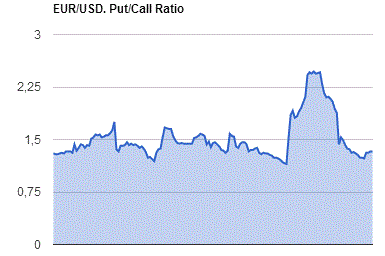
GBP/USD
Resistance levels (open interest**, contracts)
$1.3602 (1784)
$1.3504 (1871)
$1.3408 (2156)
Price at time of writing this review: $1.3320
Support levels (open interest**, contracts):
$1.3292 (438)
$1.3196 (718)
$1.3098 (2631)
Comments:
- Overall open interest on the CALL options with the expiration date August, 5 is 28778 contracts, with the maximum number of contracts with strike price $1,3400 (2156);
- Overall open interest on the PUT options with the expiration date August, 5 is 27139 contracts, with the maximum number of contracts with strike price $1,2950 (3099);
- The ratio of PUT/CALL was 0.94 versus 0.96 from the previous trading day according to data from August, 2
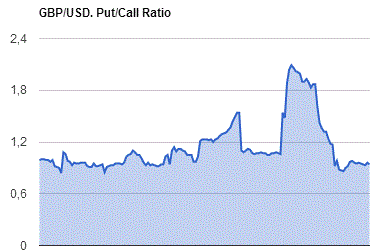
* - The Chicago Mercantile Exchange bulletin (CME) is used for the calculation.
** - Open interest takes into account the total number of option contracts that are open at the moment.
-
08:20
Staying EUR Long; Staying USD Offered - Morgan Stanley
"EUR support in the wings, staying long: There will be conclusions to be drawn for other currencies deploying NIR policy such as CHF, SEK or EUR. The short end of these currencies has priced in local central banks either keeping current monetary accommodation in place or cutting rates even further.
The Japanese experience could undermine this expectation, adding another reason why EUR should rally from here. In line with our interest rate strategy team, we see rate and yield differentials becoming more EURUSD-supportive. EURGBP longs remain our best trade.*
Staying USD offered: Increasingly, we differentiate between currencies with 'exploited' and still normal, i.e., positively yielding curves. Due to the lack of transmission mechanisms, expansionary monetary policy instruments no longer stimulate economies within an environment of 'exploited' yield curves. Here central banks will have to hope for external factors to turn the outlook for the better or they will have to aim for new - more revolutionary - measures. Friday's outcome of the BoJ meeting suggests that the authorities were not yet ready to step into new, untested territories.
Where yield curves are still normal and positively yielding, central banks are still willing to ease, as illustrated by today's RBA. However, the now more limited scope of yield curves makes them use the interest rate instrument only reluctantly. This is why the RBA did not provide forward guidance on rates today, limiting the FX- weakening impact. As a result, we do not expect much new information from Friday's Statement of Monetary Policy. In countries where yield curves are 'exploited', currencies should rise, driven by rising real yields. Consequently, USD should remain offered".
*Morgan Stanley maintains a long EUR/GBP position in its strategic portfolio and a long EUR/USD as a tactical trade of the week - efxnews.
-
08:10
Japanese government approved stimulus package
The Japanese government approved JPY 28 trillion stimulus that the Prime Minister Shinzo Abe had promised last week to bolster the economy.
The government plan includes JPY 13.5 trillion fiscal measures, of which JPY 7.5 trillion is set aside for central and local government spending starting this fiscal. Another JPY 6 trillion will be provided for low-cost loans.
The program will support infrastructure projects and reconstruction works in earthquake hit areas.
Further, media reports said the government will give cash handouts of JPY 15,000 to 22 million low-income people.
-
08:06
New Zealand jobs grow strongly
Job numbers rose a strong 3.1 percent in the year to the June 2016 quarter (as measured by the QES), driven in part by accommodation and food services, construction, and health services. This compares with a 2.2 percent increase in filled jobs in the year to the March 2016 quarter.
"There were 14,000 more jobs in accommodation and food services, up a strong 11 percent in the June year," business prices manager Sarah Williams said.
While job numbers have grown, annual wage growth remained subdued in a period of low consumer price inflation.
Annual wage inflation (as measured by the LCI) increased 1.5 percent in the June 2016 year, in line with levels for the past three years. Over the latest June year, the consumer price index, which measures the prices of goods and services that households buy, rose 0.4 percent.
"The gap between the labour cost index and inflation was 1.1 percentage points, the smallest gap since the end of 2014," Williams said.
The 1.5 percent increase in the LCI in the June 2016 year compares with a 1.6 percent increase in the year to the March 2016 quarter. Private sector wage inflation was 1.6 percent for the latest June year; for the public sector it was 1.3 percent.
-
07:46
ANZ Commodity Price Index up 2% in July
The ANZ Commodity Price Index continued its recent run of form with world prices up a further 2.0% m/m in July. It's the third consecutive improvement with prices up 6.9% over this period. The gains have been broad-based too, which is encouraging. However, it has to be remembered this improvement is off a near seven year low registered in April.
The other challenge is the high NZD, which continues to erode any slight improvement in world prices back to New Zealand exporters. In fact, while world prices have risen by 6.9% over the last three months, NZD prices have only improved by 2.5% over the same period and remain below the same time last year (-5.7% y/y). The NZD/USD is up 7% and trade-weighted index 8% compared with last year. Many exporters have worked hard on new innovations, productivity drivers and fostering new business, but sometimes this can only take things so far.
-
07:44
China's services sector activity decreased in July
Caixin services PMI fell in July to 51.7 from 52.7 the previous value. The index was also lower than the official data on business activity index of the services sector, which amounted to 53.9 points.
Caixin PMI is a leading indicator of China's state sector services. A value above 50 indicates growth, while falling below this level indicates contraction.
All index categories showed signs of deterioration. The greater deterioration observed in the employment category, which kept growing in the last three months.
-
03:45
China: Markit/Caixin Services PMI, July 51.7 (forecast 52.9)
-
01:36
Australia: AIG Services Index, July 53.9
-
00:31
Currencies. Daily history for Aug 02’2016:
(pare/closed(GMT +3)/change, %)
EUR/USD $1,1222 +0,53%
GBP/USD $1,3350 +1,28%
USD/CHF Chf0,9644 -0,35%
USD/JPY Y100,91 -1,44%
EUR/JPY Y113,24 -0,90%
GBP/JPY Y134,72 -0,12%
AUD/USD $0,7603 +0,91%
NZD/USD $0,7235 +0,94%
USD/CAD C$1,3104 -0,18%
-
00:01
Schedule for today, Wednesday , Aug 03’2016:
(time / country / index / period / previous value / forecast)
01:45 China Markit/Caixin Services PMI July 52.7 52.9
07:50 France Services PMI (Finally) July 49.9 50.3
07:55 Germany Services PMI (Finally) July 53.7 54.6
08:00 Eurozone Services PMI (Finally) July 52.8 52.7
08:30 United Kingdom Purchasing Manager Inde Services July 52.3 47.4
09:00 Eurozone Retail Sales (MoM) June 0.4% 0.1%
09:00 Eurozone Retail Sales (YoY) June 1.6% 1.7%
12:15 U.S. ADP Employment Report July 172 170
13:45 U.S. Services PMI (Finally) July 51.4 50.9
14:00 U.S. ISM Non-Manufacturing July 56.5 56
14:30 U.S. Crude Oil Inventories July 1.671
-
